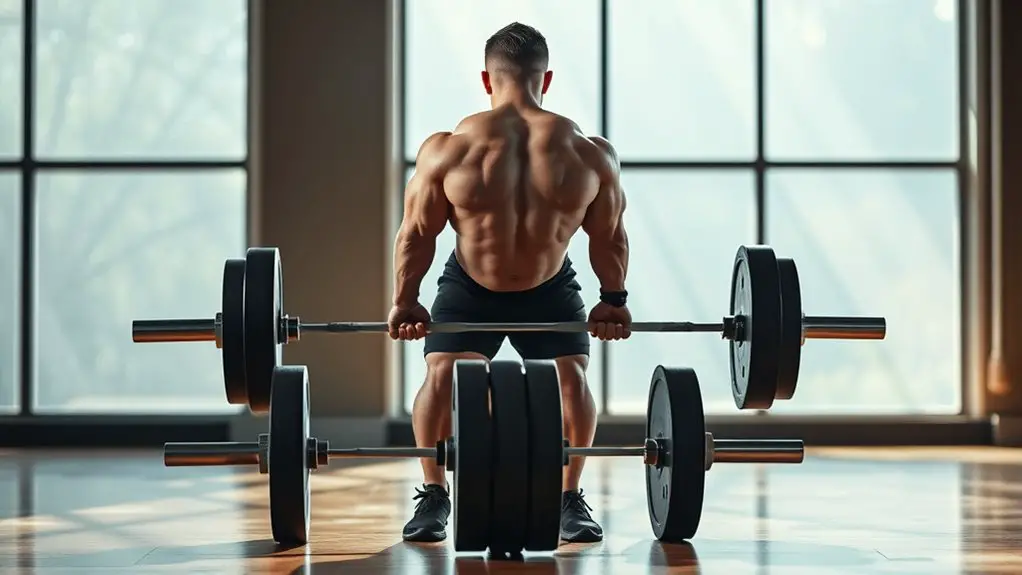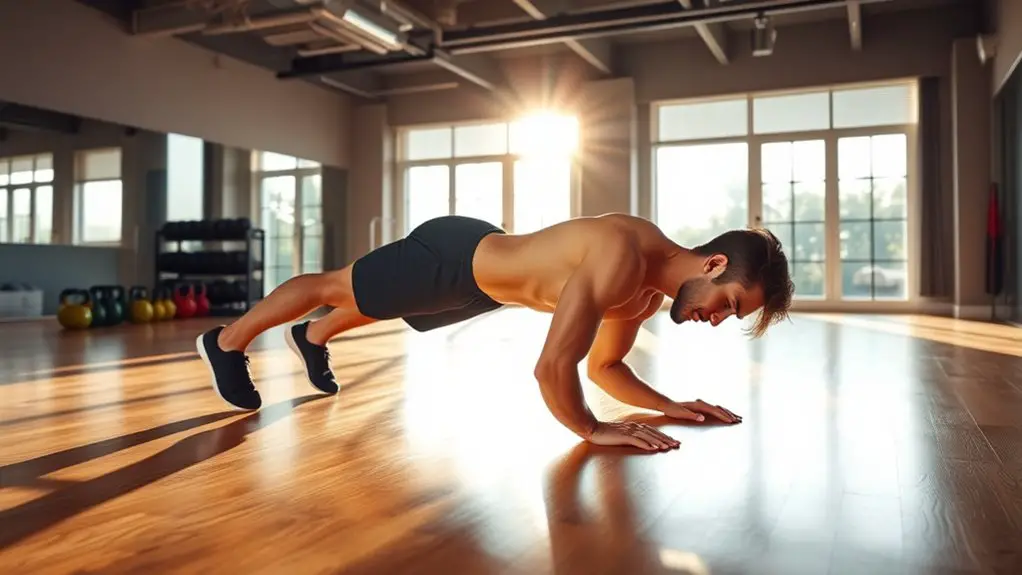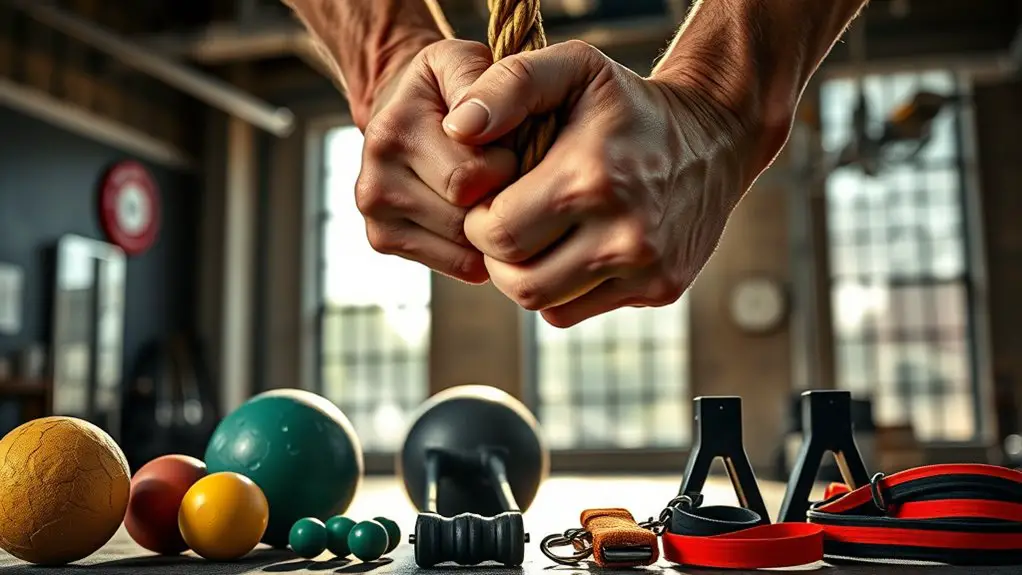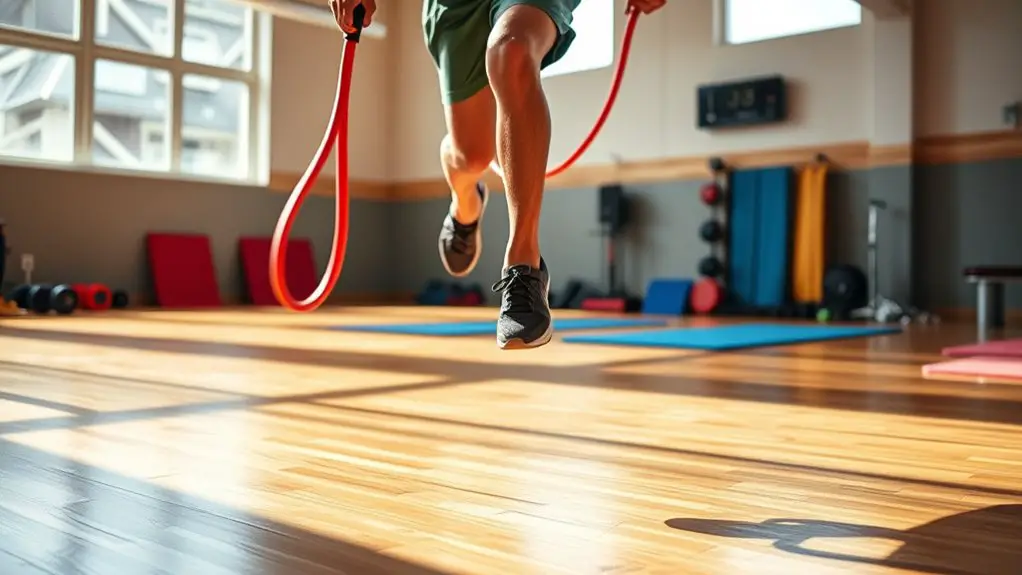To deadlift properly for athletic strength, start by standing with your feet hip-width apart, toes slightly outward. Approach the bar close to your shins, bend at your hips and knees, and grip the bar just outside your legs. Engage your core and keep a straight back as you lift. Drive through your heels, ensuring the bar stays close to your body. Gradually increase weights and perfect your technique. Discover more tips to maximize your deadlifting effectiveness and strength gains.
Understanding the Deadlift: Benefits and Importance
When you think about building strength, the deadlift often stands out as a fundamental exercise that shouldn't be overlooked. This powerful movement engages multiple muscle groups, from your glutes to your back, making it a time-efficient way to enhance overall strength. By mastering the deadlift, you're not just lifting weights; you're empowering yourself. It builds a solid foundation, improves your posture, and boosts athletic performance, giving you the freedom to tackle various physical challenges. Plus, the deadlift cultivates mental resilience, teaching you to push through limits. As you incorporate this exercise into your routine, you'll find yourself feeling stronger and more confident, ready to embrace life's adventures with vigor and enthusiasm. Don't underestimate the deadlift; it's a key to releasing your potential.
Essential Equipment for Deadlifting
To deadlift effectively, you'll need a few essential pieces of equipment that can enhance your performance and safety. The right gear not only supports your body but also boosts your confidence during heavy lifts. Here's a quick overview:
| Equipment | Purpose | Benefits |
|---|---|---|
| Weight Plates | Add resistance | Increases strength |
| Barbell | Main lifting tool | Allows for heavier lifts |
| Lifting Straps | Grip assistance | Reduces grip fatigue |
| Weightlifting Shoes | Improved stability | Enhances power transfer |
| Belt | Core support | Promotes proper form |
With this equipment, you'll be well-prepared to tackle the deadlift and reach your strength goals!
Proper Warm-Up Techniques
Before you engage in deadlifting, it's crucial to warm up properly to prepare your muscles and joints for the demands of the lift. Start with five to ten minutes of light cardio, like jogging or jumping jacks, to increase your heart rate and blood flow. Next, incorporate dynamic stretches that target your hips, hamstrings, and lower back—think leg swings and hip circles. You can also do bodyweight exercises, like squats and lunges, to activate your muscles. Finally, perform a few warm-up sets with lighter weights to groove your technique. This way, you'll enhance your performance and reduce the risk of injury. Remember, a solid warm-up makes a world of difference in your deadlifting journey!
Mastering Your Form: Step-by-Step Guide
Mastering your form is essential for safe and effective deadlifting, as even small mistakes can lead to injury or hinder your progress. Start by standing with your feet hip-width apart, toes slightly pointed out. Approach the bar, keeping it close to your shins. Bend at your hips and knees, grasp the bar with both hands just outside your legs. Engage your core and keep your back straight as you lift. Drive through your heels, extending your hips and knees simultaneously. As you lift, keep the bar close to your body. At the top, stand tall with your shoulders back. Lower the bar by hinging at the hips first, then bending your knees. Remember, practice makes perfect, so take your time!
Common Mistakes to Avoid
While deadlifting can be highly effective for building strength, many lifters make common mistakes that can compromise their form and safety. One major error is rounding your back; keep your spine neutral to avoid injuries. Another mistake is lifting too heavy too soon; prioritize form over weight to build a solid foundation. Don't forget to engage your core; a weak core can lead to instability. Additionally, avoid jerking the bar off the ground; a smooth lift provides better control. Finally, verify your feet are positioned correctly; they should be about hip-width apart. By steering clear of these pitfalls, you can release your potential and enjoy the freedom that comes with mastering the deadlift. Your body will thank you!
Progressing Your Deadlift: Tips for Strength Gains
Avoiding common mistakes is just the first step in your deadlift journey; once you've established a solid foundation, it's time to focus on progression for strength gains. Start by gradually increasing your weights. Aim for small increments to avoid injury while pushing your limits. Incorporate variations like deficit or sumo deadlifts to challenge your muscles differently. Don't neglect accessory exercises—strengthening your core and grip can enhance your deadlift performance. Also, prioritize recovery; adequate rest and nutrition are key to muscle growth. Track your progress to stay motivated and adjust your goals as needed. Remember, consistency is essential, so keep pushing forward, and enjoy the freedom that comes with increased strength and capability.
Incorporating Deadlifts Into Your Training Routine
To effectively incorporate deadlifts into your training routine, it's essential to find the right balance among your workouts. Start by scheduling deadlifts once or twice a week, allowing adequate recovery time for your muscles. Pair them with complementary exercises like squats or lunges to enhance your overall strength. Listen to your body—if you feel fatigued or sore, adjust your intensity or frequency. Remember, flexibility is key; you can shift your routine as needed to fit your energy levels and goals. Don't hesitate to experiment with variations like sumo or Romanian deadlifts to keep things fresh. Ultimately, the goal is to integrate deadlifts in a way that empowers your performance and leaves you feeling free and strong.
Frequently Asked Questions
Can Deadlifting Help Improve My Athletic Performance in Other Sports?
Yes, deadlifting can definitely boost your athletic performance. It builds core strength, enhances power, and improves overall stability, which translates well into various sports. Just remember to practice proper form to avoid injuries and maximize benefits.
How Often Should I Include Deadlifts in My Training Schedule?
In the dance of strength, you should weave deadlifts into your routine about once or twice a week. This'll keep your muscles engaged, boost your performance, and give you the freedom to excel in your sport.
What Is the Ideal Age to Start Deadlifting?
The ideal age to start deadlifting really varies for everyone. Generally, teens can begin with proper guidance, focusing on technique. It's all about building strength safely while enjoying your freedom to explore fitness.
Are There Any Specific Diets That Enhance Deadlift Performance?
When it comes to enhancing your deadlift performance, focusing on a balanced diet rich in protein, healthy fats, and complex carbs can make a difference. Stay hydrated, and don't forget to fuel your workouts!
How Do I Know if I'm Lifting Too Much Weight?
If you're struggling to maintain form or feeling excessive fatigue, you might be lifting too much weight. Listen to your body; it's your best guide. Prioritize strength over ego, and enjoy the freedom of progress!




